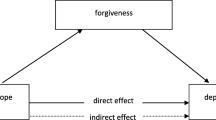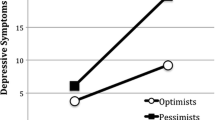Abstract
This study used a short-term prospective designin an unselected sample of undergraduates to test fivehypotheses derived from the symptom component of thehopelessness theory of depression (Abramson, Metalsky, & Alloy, 1989). In congruence withhopelessness theory, hopelessness was uniquelyassociated both concurrently and prospectively withsymptoms of depression but not anxiety. The hypothesizedhopelessness depression symptoms correlated with one anothermore highly than they correlated with other depressivesymptoms not hypothesized to be part of hopelessnessdepression or with symptoms of other psychopathology. Hopelessness predicted prospectively four ofthe eight symptoms hypothesized to be part of thehopelessness depression symptom profile and showed atrend (p < .05) to predict an additional twohopelessness depression symptoms. Hopelessness did notpredict any nonhopelessness depression symptoms or anysymptoms of anxiety disorders (somatic anxiety, phobias,obsessions/compulsions). In addition, the attributional diathesis-stress interaction featured in thetheory predicted hopelessness depression symptomsprospectively and specifically, and was mediated byhopelessness. However, at odds with the theory,hopelessness failed to predict two of the symptoms (sadness,low energy) hypothesized to be part of hopelessnessdepression and it did predict some symptoms of otherpsychopathology, primarily psychoticism, and,marginally, hostility and paranoia.
Similar content being viewed by others
REFERENCES
Abramson, L. Y., Alloy, L. B., & Hogan, M. E. (1997). Cognitive/personality subtypes of depression: Theories in search of disorders. Cognitive Therapy and Research, 21,247–265.
Abramson, L. Y., Alloy, L. B., & Metalsky, G. I. (1988). The cognitive diathesis-stress theories of depression: Toward an adequate evaluation of the theories' validities. In L. B. Alloy (Ed.), Cognitive processes in depression(pp. 3–30). New York: Guilford Press.
Abramson, L. Y., Alloy, L. B., & Metalsky, G. I. (1995). Hopelessness depression. In G. M. Buchanan & M. E. P. Seligman (Eds.), Explanatory style(pp. 113–134). Hillsdale, NJ: Erlbaum.
Abramson, L. Y., Metalsky, G. I., & Alloy, L. B. (1989). Hopelessness depression: A theory-based subtype of depression. Psychological Review, 96,358–372.
Akiskal, H. S., & McKinney, W. T. (1975). Overview of recent research in depression: Integration of ten conceptual models into a comprehensive frame. Archives of General Psychiatry, 32,285–305.
Alloy, L. B., Abramson, L. Y., Metalsky, G. I., & Hartlage, S. (1988). The hopelessness theory of depression: Attributional aspects. British Journal of Clinical Psychology, 27,5–21.
Alloy, L. B., & Clements, C. M. (1992). Illusion of control: Invulnerability to negative affect and depressive symptoms after laboratory and natural stressors. Journal of Abnormal Psychology, 101,234–245.
Alloy, L. B., Hartlage, S., & Abramson, L. Y. (1988). Testing the cognitive diathesis-stress theories of depression: Issue s of research design, conceptualization, and assessment. In L. B. Alloy (Ed.), Cognitive processes in depression(pp. 31–73). New York: Guilford Press.
Alloy, L. B., Just, N., & Panzarella, C. (1997). Attributional style, daily life events, and hopelessness depression: Subtype validation by prospective variability and specificity of symptoms. Cognitive Therapy and Research, 21,321–344.
Alloy, L. B., Kelly, K. A., Mineka, S., & Clements, C. M. (1990). Comorbidity in anxiety and depressive disorders: A helplessness-hopelessness perspective. In J. D. Maser & C. R. Cloninger (Eds.), Comorbidity in anxiety and mood disorders(pp. 499–543). Washington, DC: American Psychiatric Press.
Alloy, L. B., Lipman, A. J., & Abramson, L. Y. (1992). Attributional style as a vulnerability factor for depression: Validation by past history of mood disorders. Cognitive Therapy an d Research, 16,391–407.
American Psychiatric Association. (1980). Diagnostic and statistical manual of mental disorders(3rd ed.). Washington, DC: Author.
American Psychiatric Association. (1994). Diagnostic and statistical manual of mental disorders(4th ed.). Washington, DC: Author.
Baron, R. M., & Kenny, D. A. (1986). The moderator-mediator variable distinction in social psychological research: Conceptual, strategic, and statistical considerations. Journal of Personality and Social Psychology, 51,1173–1182.
Beck, A. T. (1976). Cognitive therapy and the emotional disorders.New York: International Universities Press.
Beck, A. T., Brown, G., Berchick, R. J., Stewart, B. L., & Steer, R. A. (1990). Relationship between hopelessness and ultimate suicide: A replication with psychiatric outpatients. American Journal of Psychiatry, 147,190–195.
Beck, A. T., Riskind, J. H., Brown, G., & Steer, R. A. (1988). Levels of hopelessness in DSM-III disorders: A partial test of content specificity in depression. Cognitive Therapy and Research, 12,459–469.
Beck, A. T., Steer, R. A., Beck, J. S., & Newman, C. F. (1993). Hopelessness, depression, suicidal ideation, and clinical diagnosis of depression. Suicide and Life Threatening Behavior, 23,139–145.
Beck, A. T., Steer, R. A., & Garbin, M. G. (1988). Psychometric properties of the Beck DePression Inventory: Twenty-five years of evaluation. Clinical Psychology Review, 8,77–100.
Beck, A. T., Steer, R. A., Kovacs, M., & Garrison, B. (1985). Hopelessness and eventual suicide: A 10-year prospective study of patients hospitalized with suicidal ideation. American Journal of Psychiatry, 142,559–563.
Beck, A. T., Ward, C. H., Mendelson, M., Mock, J., & Erbaugh, J. (1961). An inventory for measuring depression. Archives of General Psychiatry, 4,561–571.
Beck, A. T., Weissman, A., Lester, D., & Trexler, L. (1974). The measurement of pessimism: The Hopelessness Scale. Journal of Consulting and Clinical Psychology, 42,861–865.
Clark, D. A., & Beck, A. T. (1989). Cognitive theory and therapy of anxiety and depression. In P. C. Kendall & D. Watson (Eds.), Anxiety and depression: Distinctive and overlapping features(pp. 379–411). New York: Academic Press.
Clark, D. A., Beck, A. T., & Brown, G. (1989). Cognitive mediation in general psychiatric outpatients: A test of the content-specificity hypothesis. Journal of Personality and Social Psychology, 56,958–964.
Clark, D. A., Beck, A. T., & Stewart, B. (1990). Cognitive specificity and positive-negative affectivity: Complementary or contradictory views on anxiety and depression? Journal of Abnormal Psychology, 99,148–155.
Cohen, J., & Cohen, P. (1983). Applied multiple regression/correlation analysis of the behavioral sciences(2nd ed.). Hillsdale, NJ: Erlbaum.
Craighead, W. E. (1980). Away from a unitary model of depression. Behavior Therapy, 11,122–128.
Depue, R. A., & Monroe, S. M. (1978). Learned helplessness in the perspective of the depressive disorders. Journal of Abnormal Psychology, 87,3–20.
Derogatis, L. R. (1977). The SCL-90 Manual I: Scoring, administration and procedures for SCL-90.Baltimore: Clinical Psychometric Research.
Derogatis, L. R., Lipman, R. S., & Covi, L. (1973). SCL-90: An outpatient psychiatric rating scale-preliminary report. Psychopharmacology Bulletin, 9,13–25.
Derogatis, L. R., Lipman, R. S., Rickels, K., Uhlenhuth, E. H., & Covi, L. (1974). The Hopkins Symptom Checklist (HSCL): A self-report symptom inventory. Behavioral Science, 19,1–15.
Derogatis, L. R., Rickels, K., & Rock, A. F. (1976). The SCL-90 and the MMPI: A step in the validation of a new self-report scale. British Journal of Psychiatry, 128,280–289.
Hamilton, E. W., & Abramson, L. Y. (1983). Cognitive patterns and major depressive disorder: A longitudinal study in a hospital setting. Journal of Abnormal Psychology, 92,173–184.
Haslam, N., & Beck, A. T. (1994). Subtyping major depression: A taxometric analysis. Journal of Abnormal Psychology, 103,686–692.
Joiner, T. E., Jr. (1994). Covariance of baseline symptom scores in prediction of future symptom scores: A methodological note. Cognitive Therapy and Research, 18,497–504.
Joiner, T. E., Jr., Abramson, L. Y., Alloy, L. B., Metalsky, G. I., & Schmidt, N. (1998). Taxometric evidence for a hopelessness depression subtype.Manuscript submitted for publication.
Klein, D. F. (1974). Endogenomorphic depression: Conceptual and terminological revision. Archives of General Psychiatry, 31,447–454.
Kraepelin, E. (1913). Manic-depressive insanity and paranoia. In Textbook of psychiatry(R. M. Barclay, Trans.). Edinburgh, Scotland: Livingstone.
Leber, W. R., Beckham, E. E., & Danker-Brown, P. (1985). Diagnostic criteria for depression. In E. E. Beckham & W. R. Leber (Eds.), Handbook of depression: Treatment, assessment, and research(pp. 343–371). Homewood, IL: Dorsey Press.
Metalsky, G. I., Halberstadt, L. J., & Abramson, L. Y. (1987). Vulnerability to depressive mood reactions: Toward a more powerful test of the diathesis-stress and causal mediation components of the reformulated theory of depression. Journal of Personality and Social Psychology, 52,386–393.
Metalsky, G. I., & Joiner, T. E., Jr. (1992). Vulnerability to depressive symptomatology: A prospective test of the diathesis-stress and causal mediation components of the hopelessness theory of depression. Journal of Personality and Social Psychology, 63,667–675.
Metalsky, G. I., & Joiner, T. E., Jr. (1997). The Hopelessness Depression Symptom Questionnaire. Cognitive Therapy and Research, 21,359–384.
Metalsky, G. I., Joiner, T. E., Jr., Hardin, T. S., & Abramson, L. Y. (1993). Depressive reactions to failure in a naturalistic setting: A test of the hopelessness and self-esteem theories of depression. Journal of Abnormal Psychology, 102,101–109.
Monroe, S. M., & Simons, A. D. (1991). Diathesis-stress theories in the context of life stress research: Implications for the depressive disorders. Psychological Bulletin, 110,406–425.
Needles, D. J., & Abramson, L. Y. (1990). Positive life events, attributional style, and hopefulness: Testing a model of recovery from depression. Journal of Abnormal Psychology, 99,156–165.
Nolen-Hoeksema, S., Girgus, J. S., & Seligman, M. E. P. (1986). Learned helplessness in children: A longitudinal study of depression, achievement, and explanatory style. Journal of Personality and Social Psychology, 51,435–442.
Nolen-Hoeksema, S., Girgus, J. S., & Seligman, M. E. P. (1992). Predictors and consequences of childhood depressive symptoms: A 5-year longitudinal study. Journal of Abnormal Psychology, 101,405–422.
Nunnally, J. C. (1967). Psychometric theory.New York: McGraw-Hill.
Peterson, C., Semmel, A., von Baeyer, C., Abramson, L. Y., Metalsky, G. I., & Seligman, M. E. P. (1982). The Attributional Style Questionnaire. Cognitive Therapy and Research, 6,287–300.
Seligman, M. E. P., Abramson, L. Y., Semmel, A., & von Baeyer, C. (1979). Depressive attributional style. Journal of Abnormal Psychology, 88,242–247.
Spangler, D. L., Simons, A. D., Monroe, S. M., & Thase, M. E. (1993). Evaluating the hopelessness model of depression: Diathesis-stress and symptom components. Journal of Abnormal Psychology, 102,592–600.
Spielberger, C. D., Gorsuch, R. L., & Lushene, R. E. (1970). Manual for the State-Trait Anxiety Inventory.Palo Alto, CA: Consulting Psychologists Press.
Spitzer, R. S., Endicott, J., & Robins, E. (1978). Research diagnostic criteria: Rationale and reliability. Archives of General Psychiatry, 35,773–782.
Whisman, M. A., Miller, I. W., Norman, W. H., & Keitner, G. I. (1995). Hopelessness depression in depressed inpatients: Symptomatology, patient characteristics, and outcome. Cognitive Therapy and Research, 19,263–284.
Whisman, M. A., & Pinto, A. (1997). Hopelessness depression in depressed inpatient adolescents. Cognitive Therapy and Research, 21,345–358.
Young, M. A., Halper, I. S., Clark, D. C., Scheftner, W., & Fawcett, J. (1992). An item-response theory evaluation of the Beck Hopelessness Scale. Cognitive Therapy and Research, 16,579–587.
Rights and permissions
About this article
Cite this article
Alloy, L.B., Clements, C.M. Hopelessness Theory of Depression: Tests of the Symptom Component. Cognitive Therapy and Research 22, 303–335 (1998). https://doi.org/10.1023/A:1018753028007
Issue Date:
DOI: https://doi.org/10.1023/A:1018753028007




